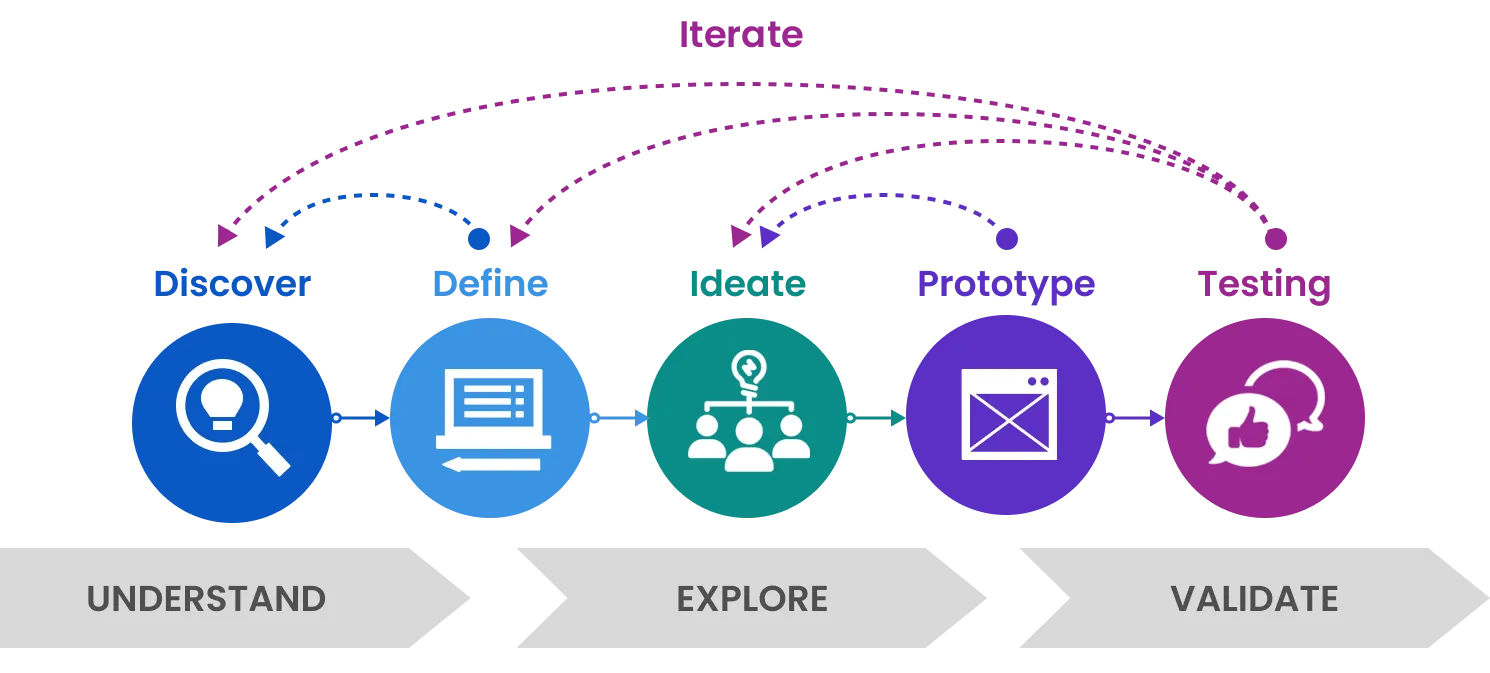UI refers to the visual elements and how the colors, icons, text, and buttons are used and arranged in an app. UX, on the other hand, refers to the navigation, ease of use, speed, responses, and overall experience of a user using an app. Together, UI and UX influence what kind of button will lead a user to take action and whether that user will tap or swipe.
The successful intertwining of aesthetic and functional experience is achieved through Design Thinking, a human-centered approach to design based on how users think, feel, and behave. In Design Thinking, designers, business analysts, project stakeholders, and targeted users collaborate to implement good UI and UX in an app to create a delightful, meaningful, and holistic experience.
How does a good UI/UX look and feel?
Creating an inviting and intuitive user experience UI/UX is like designing a space that draws people into your store and makes them want to stay, browse, buy, and return. Your shop window needs to display the latest and trendiest outfits so your target customers will want to come in. If you have a promotion, it should be announced with a prominent and clear sign. Inside, you need to arrange the clothes to make it easy for shoppers to find their size and favorite colors. There should be enough well-lit fitting rooms to make clothes look so good on shoppers that they will beeline to the cashier. Near the payment counters, you can display small items like socks that customers can quickly grab and add to their carts.
As in a physical store, the same careful blend of aesthetics, psychology, and functionality — through UI and UX — must be present in your app to succeed.
Let us appreciate how some popular apps today have a well-crafted UI and UX:
-
- Apple. The digital device giant’s website showcases how the effective use of color, typography, and spacing creates a visually appealing and intuitive environment. Apple uses high-quality imagery, consistent branding, and clear and concise text to guide users through products, specifications, and prices. The result is a shopping experience that is smooth, satisfying, and makes you come back for more.
- Airbnb. In the early days of Airbnb, the founders observed that listings had low-quality photos, if they had any photos at all. This resulted in fewer bookings and a negative experience. To respond, Airbnb hired freelance photographers to take high-quality photos for the hosts, giving potential guests more visual information and increasing conversions through homes being booked.
- Duolingo. Duolingo gamifies the learning process by engaging users through a series of rewarding interactions — earning points, advancing levels, and receiving immediate feedback. The approach makes learning enjoyable, encourages constant usage, and demonstrates how good UI and UX are applied.
Benefits of well-planned, well-Implemented UI/UX
Investing in quality UI/UX design brings substantial benefits:
-
- Cost savings. Addressing user needs effectively from the outset avoids costly revisions. Good design reduces the risk of user abandonment due to poor experiences.
- Speed-to-market. A clear understanding of the user accelerates development, reducing the time from concept to launch by prioritizing features that matter most to the target audience.
- Enhanced user satisfaction. Design thinking’s empathetic approach leads to products that genuinely meet user needs, promoting satisfaction and loyalty.
- Competitive advantage. Standout UI/UX can differentiate a product in a crowded market, attracting and retaining users.
Creating great UI and UX through Design Thinking
At Stratpoint, we navigate the journey from a concept to a user-friendly digital product through these Design Thinking stages:
- Discover. This phase is about understanding the user’s world: their needs, frustrations, and desires. It involves user research, interviews, and empathy maps to get into the user’s shoes.
- Define. Based on insights from the discovery phase, actionable problems and objectives are identified.
- Ideate. With a well-defined problem in mind, the team brainstorms various creative solutions, encouraging wild ideas and divergent thinking.
- Prototype. The team visualizes the solution through prototypes or scaled-down versions of the product, ranging from simple sketches to interactive digital models.
- Testing. Feedback is gathered from users, informing the next cycle of ideation and prototyping until the solution meets the users’ needs satisfactorily.
-

Co-create with experts
Executing Design Thinking requires skills and experience that not all software development teams may have. For this reason, companies like the top retailer SM turn to Stratpoint for guidance.
During the COVID-19 pandemic, SM endeavored to continue delivering goods to its loyal customers and helping its mall tenants remain in business. To do this, SM created a new shopping experience: SM Malls Online. But as the demand grew, so did the complexity of receiving orders, coordinating with stores, picking and packing items, and bringing them to customers’ doorsteps.
That’s when they enlisted the help of Stratpoint to build a centralized web application for end-to-end order fulfillment. Stratpoint’s Design Thinking team worked with SM and its app users to conceptualize, design, and implement a shopping app that would give the same ease and high-quality experience as their physical malls had done.
Following the tried and tested Design Thinking process, SM and Stratpoint successfully deployed the SM Malls Online app that now fulfills thousands of orders across SM malls every single month. The same app was awarded the 2022 AIBP ASEAN Enterprise Innovation Award in recognition of SM’s commitment to help its 15,000+ MSME tenants while serving its own customers during the difficult period of the COVID-19 pandemic.
Without Design Thinking, developers risked creating features and functionalities that could result in negative user experiences like difficulty searching for products, slow loading times, paying for unavailable items, receiving incorrect orders, and more. Taking the time to design the application’s features, interface, and experience helped SM have a better understanding of their customers and prepare a solution that would uphold the brand’s reputation.
If, like SM, you want to launch a well-planned, well-crafted software, reach out to Stratpoint via the form below. You may also email us at hello@stratpoint.com.
Stratpoint has over 25 years of experience in software development, having created apps for leading brands, downloaded by millions of users globally.




